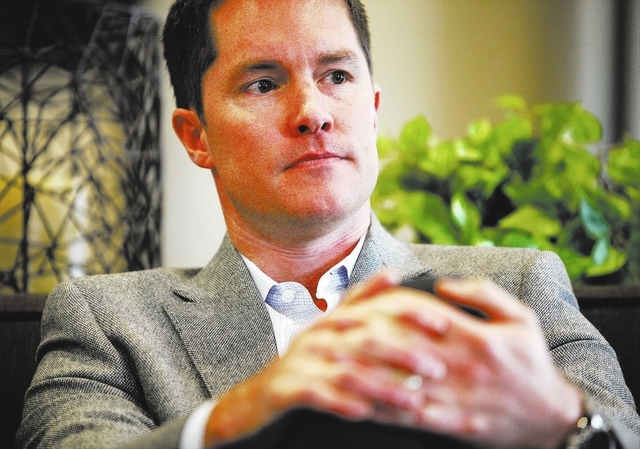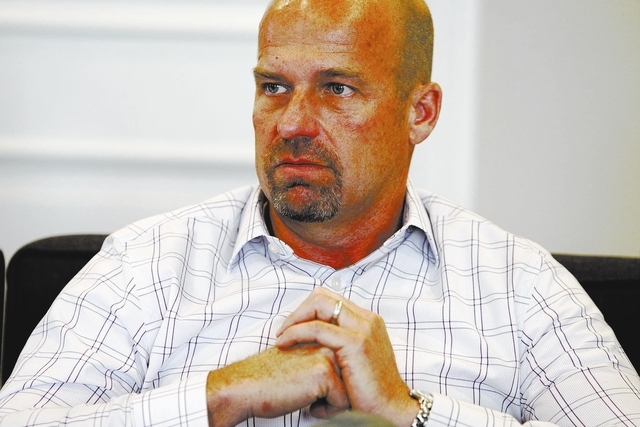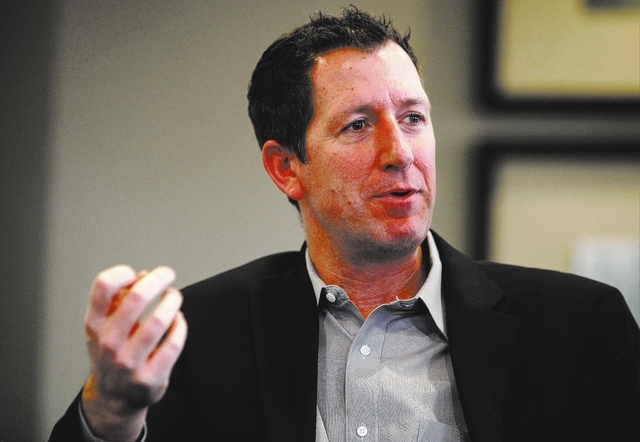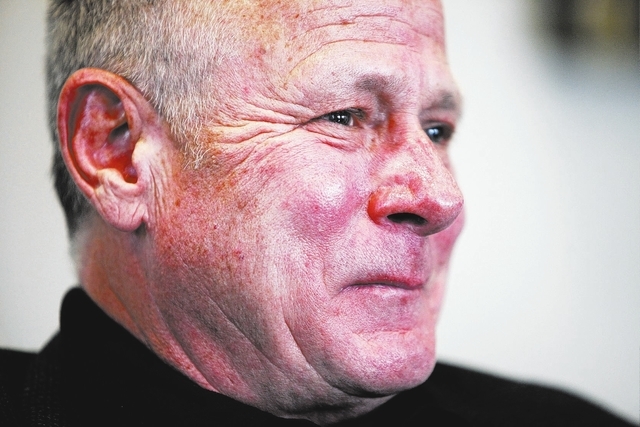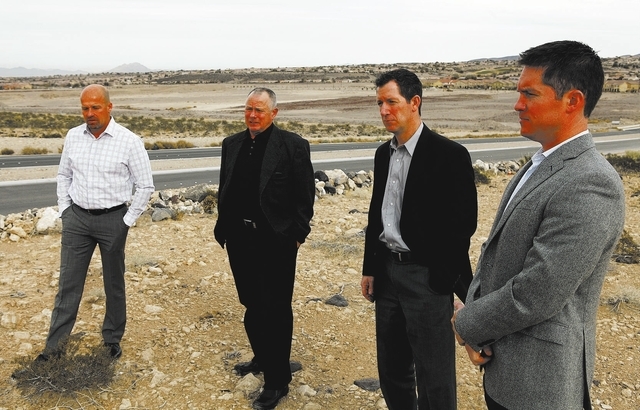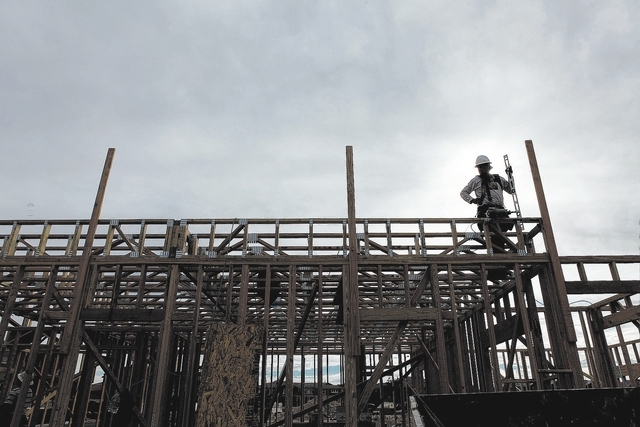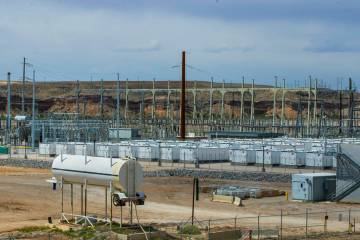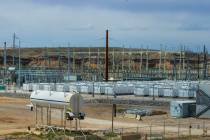Henderson parks ground breaking signals recovery from housing meltdown
Two new parks broke ground in Henderson on Saturday.
That may not mean a huge amount to you, but for Southern Nevada’s housing market, the projects are a fresh sign of recovery from a major meltdown.
That’s because these two parks are inside the Inspirada master plan, launched in 2006 at the peak of the bubble — at bubble-era land prices. The recession hit in 2007, and building at Inspirada, as in the rest of the market, virtually ground to a halt in 2008. The project went into Chapter 11 bankruptcy in 2009; four of its original builders agreed to buy out the project in late 2011.
Now, KB Home, Toll Bros., Pardee Homes and Beazer Homes are ready to begin large-scale construction again. They’ll debut nearly 15 product lines and about 40 models at Inspirada in 2014, and begin grading on two new villages. The community they’re building will look different from the 1,953-acre Inspirada’s early days. Where the predownturn phase focused exclusively on neotraditional design, with small, often attached homes with garages opening onto rear alleys, the revived Inspirada will mostly go back to local basics, with larger, single-family homes and garages with driveways out front.
That will also mean fewer homes than planned. Today’s Inspirada will have 8,500 homes, down from the 10,000 initially expected. About 1,100 of those homes are already built.
The Review-Journal sat down Tuesday with executives of the community’s four builders to talk about Inspirada’s future, as well as market challenges they see in the year ahead.
How important is this weekend for Inspirada as far as community milestones, and getting things back on track?
Robert McGibney, president of KB Home’s Las Vegas division: It’s important because (these are really major parks). When people come out and see the scale, I think they’re going to be really impressed. Other master plans in town have tended to sell houses first. You’ve got people living there, and parks may or may not come later. We’re putting them in now, before we go into this next phase of development.
Klif Andrews, president of Pardee Homes’ Las Vegas division: To take it even further, we’re going to have three parks totaling more than 40 acres by year-end. That’s a gigantic package of parks before we move many new residents in.
Why did you want to do things that way?
Andrews: It’s important for us to demonstrate that Inspirada is going forward, and Inspirada is really anchored by our parks, our open areas, our play areas and the amenities we can bring our buyers. It’s not just a home site. We’re eager to demonstrate that, and get our buyers excited by that. The city of Henderson has been an important part of that. They’re very excited about seeing these parks developed as well.
McGibney: It’s really hard to explain with words or a drawing what we’re creating and what we’re offering the buyer. So if we build it, you can go touch it and feel it. And I think buyers are going to be really happy with what they see.
You’re all unveiling new models in 2014. How will the homes differ from the first wave of development?
McGibney: The product has evolved. We’re constantly surveying buyers to figure out what exactly they want in a house and a floor plan. The major thing is that most of the product in Inspirada now is alley-loaded. We found that while there’s a market for that, we want to be able to market to the broader home-buying public as well, so we’re going to have more traditional product along with the alley-loaded product.
Andrews: Homes are going to be larger. They’re going to be more family-oriented. These are going to be homes similar to what we’re building in other great communities in Henderson. They’re not going to be as focused on smaller, alley-loaded, attached homes. We’re excited about our ability to bring more variety, more family-style homes and floor plans that will fit with the great amenities and parks package.
David Straub, division president of Toll Bros.: Overall, the complexion of Inspirada isn’t going to be much different. It’s still going to be a walkable community that’s inviting to every demographic.
Any idea how many homes a year you’ll be building at Inspirada’s peak?
McGibney: I’m not going to take a shot at that. I wish I knew.
Bill June, president of Beazer Homes’ Las Vegas division: We all threw our crystal balls away after (the recession).
Few people predicted that Las Vegas would crash worse than just about any other market. Why did it?
McGibney: It was really a response to the run-up. The run-up was severe, and so was the coming back down.
Andrews: We were similar to other markets that were high-growth markets, like Florida and Phoenix, and high-growth markets were impacted the most when growth stopped. The good news is that it really got affordability back into play, and we’re still enjoying the benefits of that.
What would you say was the home-building industry’s role in the housing crash?
Andrews: I don’t know that we had a role. We were building for demand. We never did build crazy inventories. It was never an inventory issue. It was more about the credit markets failing, and they failed everywhere in the world and at every asset class. The automobile industry tanked too, so I don’t know that we’re any different.
What lessons from the crash should we take as a market, not just as builders, but as lenders and consumers?
June: Let’s not let it happen again.
How do we prevent it?
Straub: I don’t know that we sitting in this room can put together a recipe to prevent it.
Andrews: Call Congress.
Where are we in the market’s housing recovery?
Andrews: We’re not full speed. We’re seeing healthy demand, but we still have a lot of issues with buyers being able to buy, and being able to afford what’s on the market. But we continue to see a lot of positive signs, and 2013 was a good year for everybody.
Straub: We’re seeing a lot of people who were bruised in the downturn coming back. They’ve worked themselves through their credit issues, and they’ve saved money to be able to afford a down payment on a home. They’re actually excited and emotionally involved in the buying process. And it’s a pleasure to have people coming in with smiling faces, and they’re ready to move forward again. I think that’s a testament to what we’re doing at Inspirada. We’re moving forward.
There’s still a big difference between the higher median new home and the lower resale price. How will that affect your ability to compete for buyers?
Andrews: We’re continuing to see buyers excited at the prospect of a new home with new design features in new neighborhoods with new amenities, and they do pay a premium for that. But it’s not a gigantic premium. It’s reasonable, and buyers are very excited about new products.
McGibney: When you consider the all-in costs of homeowership, whether it’s energy efficiency or other things about a new home, it’s really not a lot different when you boil it down and look at the cost on a monthly basis, even though the initial price is higher.
Several other master plans, including Cadence in Henderson and Park Highlands and the former Kyle Canyon up north, are looking to bounce back from stalled construction during the recession. Is there room for all of you, especially given the number of existing vacant homes in the market?
June: What it allows is diversity across the valley. Certain people like to live on the west side of town, others in Henderson. So I think it allows for diversity in places to live.
Straub: And the population is growing again. People are coming back.
Andrews: Some of those master plans have quite a lead time ahead of them. They’re not planning on opening in 2014.
McGibney: People don’t realize it when they fly over Las Vegas and see all the open land, but it’s really a very land-constrained market. There’s just not that much land out there left to be purchased, short of more BLM land auctions. So that might sound like a lot of master plans, but they’re spread out fairly far geographically. Add that into the land that was available before, and where we were versus where we are now, and we have a long way to go to get back to normal.
Speaking of Bureau of Land Management auctions, the bureau will be holding one of its biggest auctions in nearly a decade later this month. Will you all be there with your checkbooks?
Andrews: Probably not. The land that’s being sold isn’t necessarily strong development land. A lot of it is in rural preservation areas, so it’s very low density (in terms of numbers of homes allowed).
McGibney: Same for us. Low-density land has a high development cost. You end up with a very high price point for those buyers, and that’s not where we want to be right now. There’s a market for that product. It’s just not really our niche.
Those rural-preservation neighborhoods are an issue as Clark County officials re-evaluate their planning process. What role are your companies playing in that re-evaluation?
Andrews: Every builder here is part of a dialogue with the county, and even potentially with the BLM, for future planning. Most of us are on a committee with the Southern Nevada Home Builders Association that’s interfacing with Clark County Planning on their future process. I think everybody has a stake in trying to do a thorough job of planning Clark County for the future. It’s critical that we continue to be able to get affordable land so that we can service all sectors of our market, not just the higher-price sectors.
In a perfect world, what would come from this dialogue?
Andrews: First of all, some very rational planning — that we have the ability to plan in an organized fashion. I think the county would like to see fewer nonconforming zoning changes (when a developer requests a different land use from its original intent). But to get there, they have to rationally plan to allow for good residential products. So that’s kind of the back-and-forth right now.
Aside from land availability, what other challenges do you face in 2014?
June: Interest rates are going up, and the new FHA limits are going to have an impact also. The loan amounts buyers can qualify for will be affected by the new loan cap the FHA has placed on the market. We actually dropped the most in the nation, to $287,000 (from $417,000).
How much do you see that affecting you?
June: I think we’re all going to proceed in spite of it. It’s just going to be a challenge to get buyers qualified and to find the right buyers for our communities.
Straub: Not that any of us can look in a crystal ball and see what rates are going to be at the end of 2014, but I think we can all agree they’re still historically low on average. So while there may be some tick up in the rates, I think we’ll all get through the initial repercussions of that, and everyone will kind of realize, “I can still do this. I can still afford the home, I can still come up with my down payment, and I can still move forward.”
McGibney: People might end up having to buy a smaller home, or they’d just have to find a different mortgage product than FHA financing. There are still alternatives like conventional financing. That just requires a little bit more of a down payment.
Have you seen changes in buyer behavior since interest rates began to go up in May?
June: Typically, there’s a lag. It takes a while for the buyer to catch up with what’s actually going on in the market. We’ve seen a little effect, but I think it’ll be a little more drastic as (the new FHA limit) starts taking place. If interest rates stay stable, it’s still very doable for buyers to qualify for loans.
Andrews: Right now we’re still well below 5 percent interest rates. That’s an affordable rate. That’s not terrifying to our buyers. The FHA issues are actually more of a concern for us, but there are also good, new loan products coming, with better access to conventional mortgages.
Any other big concerns on your radar for 2014?
McGibney: No. I’m excited.
Andrews: We’re all excited about 2014. We’re looking for a great year.
Contact reporter Jennifer Robison at jrobison@reviewjournal.com. Follow @J_Robison1 on Twitter.



